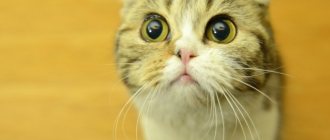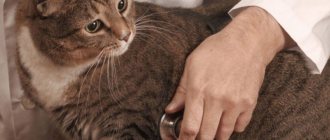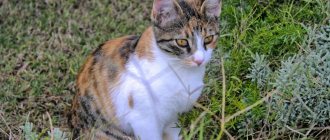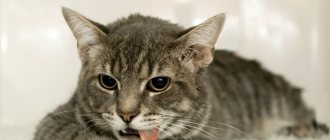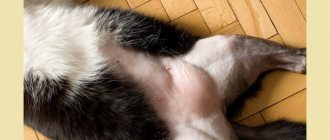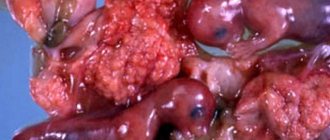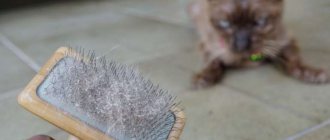There are diseases in cats that can frighten even the most experienced animal breeders and their owners. One of these diseases is convulsions in a cat that occur suddenly, and what to do, how not to get confused and panic at the sight of your pet convulsing, is what we will have to figure out in this article.
Convulsions in animals are very similar to an epileptic seizure in humans, and may even be accompanied by loss of consciousness. What are the causes of this condition in a cat?
What do cramps look like?
The most crucial point in diagnosis is the timely detection of seizures, which may look like this:
- Single muscle and fascial twitching. Most often, such symptoms can be observed while the pet is sleeping.
- Widespread cramps that involve the entire torso.
At the same time, the second group is divided into several subtypes:
- Convulsions. The cat remains fully conscious, but multiple twitching of the muscles of the limbs, tail, and muscle fibers on the face are visually detected.
- Tonic convulsions, in which the torso straightens, like a string. As a rule, such an attack is accompanied by loss of consciousness.
- Clonic seizures are characterized by small, numerous twitching of various muscle groups. In a photo or video of a cat’s seizures, you can notice a certain cyclical pattern of seizures. The contractions are chaotic, but occur at regular intervals.
There are also combined tonic and clonic convulsions, in which in the first phase there is tonic tension of the entire body.
The first phase is quickly replaced by the second, during which small fascial and muscle fibrillations occur.
Sometimes it is possible to recognize the so-called aura or a period of precursors, during which the pet begins to behave unusually, meow loudly, and run restlessly around the apartment (if this is not typical for the cat in its normal state).
Varieties of the disease
Depending on which muscle group is in spasm, there are several types of convulsions:
- local or focal (one muscle group suffers);
- unilateral (muscles on the right or left side of the body are covered);
- generalized (muscles of the whole body are covered).
Based on the duration of the attack and the nature of muscle spasms, the following types of twitching are distinguished:
- Myoclonic is the easiest type of attack to develop. They are not accompanied by pain and are often focal or unilateral. The spasms are short-lived and go away on their own.
- Clonic - longer lasting. Muscles twitch (spasms alternate with relaxations). The violation can be either local or generalized.
- Tonic - even longer and stronger. In most cases they are generalized.
- Tonic-clonic seizures in cats combine both types of spasms. During an attack, clonic convulsions gradually turn into tonic convulsions.
Why does the animal run and nervously lick itself?
Licking is normal for cats. These clean animals are so sensitive to the cleanliness of their fur that they lick themselves at every opportunity: after eating, going to the toilet, or being touched by their owners. Moreover, by licking their fur coat, they calm down. Licking can be talked about as a normal phenomenon only when it is not fanatical in nature. Why does a kitten or adult cat run around the house and lick nervously?
The cat is stressed
These animals have a very vulnerable psyche. It doesn’t take much for a pet to lose its peace of mind. This can happen due to a trip in a car, a visit to the veterinarian, quarrels in the family, the appearance of a new four-legged inhabitant in the house, moving to another room, changing place of residence, etc. All cats experience stress differently. Some begin to run aimlessly around the apartment and fanatically lick the fur. Sometimes they do this so violently that in some areas of their bodies they become completely bald.
As soon as the factor that provoked the cat’s emotional shock disappears or he gets used to new circumstances, the pet will stop being nervous. However, cats are not always able to overcome stress on their own. Sometimes they need sedatives.
Hyperesthesia syndrome
This rather rare disorder, affecting the skin, neuromuscular and nervous systems, is most often detected in kittens. The reasons for its appearance are unknown, but it is believed to be due to disruption of neurotransmitters in the brain during anxiety.
Animals with this syndrome feel tense all the time and experience increased sensitivity to touch. Their spine and tail are the most vulnerable. They lick the fur too diligently, paying special attention to the most vulnerable areas of the body, sometimes leading to the appearance of bloody wounds. Hyperesthesia syndrome can also be recognized by other symptoms:
- nervous tail beating;
- twitching of parts of the body in the back;
- sudden bursts of activity, sometimes developing into aggression;
- dilated pupils;
- tail biting;
- loud meow.
The cat has fleas, worms or other parasites
The reason for this behavior may be ecto- and endoparasites. They cause the pet a lot of suffering. Especially unbearable for them is the endless itching in places affected by external parasites, such as fleas. It prevents the tailed poor fellows from sleeping peacefully, eating, and spending time carefree. In order to somehow drown it out, they begin to rush around the house and actively lick the irritated skin, often only aggravating the situation.
Having noticed symptoms of a helminthic infestation in a cat, it is necessary to take measures to destroy the pests as quickly as possible. Antiparasitic drugs, especially if they are planned to be used to treat a kitten, should be discussed with your veterinarian.
This is interesting: Instructions for use of the drug Nobivak Rabies for cats
Causes of convulsions
All types of muscle contractions indicate that there are many factors that provoke symptoms.
To make it easier to make a diagnosis and carry out targeted treatment, the predetermining causes are divided into groups:
factors associated with brain dysfunction;- reasons that led to disruptions in the metabolic processes of the cat’s body;
- intoxication.
These are based groups that include entire lists of diseases in which sudden convulsions and seizures are possible.
Each cause of muscle contractions should be considered in detail so that you know what you have to face.
Rules for taking anticonvulsants in veterinary medicine
When a veterinarian prescribes anticonvulsants, you must adhere to the established rules:
- The dose and schedule for taking the medicine must be strictly established; chaotic use is not allowed.
- You should not spontaneously stop treating your cat - this can lead to stronger seizures.
- If the drug runs out, you need to worry about buying a new package in advance. If the medicine is given on a prescription, you must notify your veterinarian.
- The product must be stored in a safe place, out of reach of animals or children.
- You need to consult a veterinarian about compatibility with other drugs, if there is a need for supplements.
How a cat owner can help a veterinarian
The more information a doctor receives about his patient, the sooner he will be able to make a diagnosis and begin treatment.
It is important for the doctor how the seizure occurred, what the nature of the seizures was. If the cat had seizures not for the first time, then when did they occur during sleep or during a period of excitement?
Was the pet treated for any diseases and with what medications, did he have any cases of poisoning. Even the animal’s diet and its food preferences are important. If his diet includes raw meat and fish, then the veterinarian should definitely know about it.
After prescribing treatment, you must carefully follow the instructions, and if side effects occur, immediately contact a specialist again.
The first cerebral symptoms of a tumor
When the second stage of the disease develops, the meninges are excited and intracranial pressure increases. As a result, cerebral changes occur.
The tumor puts pressure on the brain, affecting its functioning.
At this time, the treatment is still successful, but it takes longer and is more difficult. The symptoms of the second stage are no longer so easily confused with the symptoms of other diseases:
- sensitivity is lost in certain areas of the body;
- sudden dizziness occurs;
- muscles weaken, often on one side of the body;
- severe fatigue and drowsiness sets in;
- seeing double.
At the same time, my general health deteriorates and morning sickness continues. All this manifests itself in the patient regardless of what part of the brain the tumor is located in.
However, it is still possible to confuse the symptoms - they are approximately the same as with epilepsy, neuropathy or hypotension. So if you find yourself with these symptoms, do not rush to panic. But be sure to go to the doctor - the unknown has never been good for anyone. And such symptoms should not be joked about.
Low body temperature
Your cat may have a low body temperature if it has been outside for too long in very cold or wet conditions. If this is extreme, we call it hypothermia. Kittens or very thin cats are especially at risk of hypothermia in harsh weather. Other symptoms of hypothermia include lethargy, slow reactions, or loss of consciousness.
Other causes of a low temperature could be shock, blood loss, toxins, poor circulation, or if your cat doesn't feel well and hasn't moved for several days.
If you think your cat is too cold, warm her up slowly and dry her fur if it's damp. You should call your veterinarian for advice if your cat still feels unwell after this.
Symptoms of seizures
Many people are probably familiar with the sensation that is caused by a muscle cramp, and at the same time there is a sharp pain. Cats experience similar sensations with muscle cramps. Visually, chaotic movements made by the paws are visible. Sometimes the opposite happens, and the pet lies on its side with tense paws curled under its stomach and clenched fingers.
The cat at this moment is very scared, screaming in pain, but does not allow the owner to touch him. During moments of convulsions, the cat’s pupils are dilated, and the whiskers are pressed tightly to the muzzle or become bristling.
If there are cramps in the hind legs, the pet may fall and the legs may be pulled in length. During a seizure, the cat may try to get up, but he will not be able to do it. But that rarely happens. Most often he is afraid to even move. In the most severe cases, the cat may urinate voluntarily and foam from the mouth. The animal does not recognize the owner, and therefore does not respond to his call. Sometimes the cat behaves aggressively.
But when the convulsions end, the pet, having calmed down, will behave as before. Although in some cases, for a short period of time, he may not find his usual places and may not even recognize his home.
Unfortunately, there are owners who, seeing their pet in this condition for the first time, do not rush to seek help from a skilled veterinarian, but wait until the seizures recur. This behavior is irresponsible, since seizures may indicate that the cat has developed a serious, and often life-threatening, illness, and when repeated seizures occur, time may already be lost.
It is very important not to make this mistake and bring your pet to the veterinarian even if after an attack of seizures he looks healthy and as cheerful as always.
Seizures in cats vary and may be accompanied by additional symptoms in different situations.
Your pet has seizures and twitching hind legs
Such convulsions occur in cases where there is a lack of a substance in the cat’s body or an excess of it. Similar conditions, with the exception of poisoning, for example, with pesticides, most often occur in elderly, pregnant, lactating, or malnourished animals. In more rare cases, such seizures may signal a stroke.
Cramps and drooling
Convulsions, which also cause drooling, may indicate the most terrible diagnosis for a cat - rabies. It is impossible to save a cat if it is already sick. He is immediately quarantined and restricted from any contact. In addition to cramps and drooling, it is necessary to carefully monitor other signs indicating the occurrence of the disease.
Cramps and foam at the mouth
Convulsions in a cat, accompanied by foam from the mouth, occur during an attack of epilepsy. But there are other reasons for this condition - kidney and liver diseases, hepatic encephalopathy, endotoxicosis, hypoglycemia.
Seizures of epilepsy with convulsions and foam at the mouth may indicate brain tumors, ischemic encephalopathy, and rarely post-traumatic or post-infarction conditions.
Cramps in a cat's hind legs while sleeping
Sometimes a cat has convulsions in his sleep. They can scare its owner. The pet is sleeping, but its eyelids, whiskers and lips are twitching, its paws, both front and back, tremble finely and often. You can hear the cat's loud meow or purr. In most cases
Such convulsions in a cat’s sleep are only a sign that he is having exciting dreams. But if he suddenly jumps up at the moment of convulsions during sleep, looks around restlessly, and then for a long time he cannot find a place for himself, then you need to sound the alarm and take the cat to the veterinarian.
Convulsions in a cat before death
In many cases, in cats, like in any other animal, the death throes are accompanied by convulsions. This condition may indicate approaching clinical death. Unfortunately, even if the course of treatment is carried out correctly, many diseases that are accompanied by seizures lead to the death of the cat. Therefore, if the veterinarian claims that your pet no longer has a single chance of recovery, you should not wait for the onset of painful and prolonged death throes. It is better not to cause him unnecessary suffering and, although it is very painful for the owner, to euthanize the animal.
Why does a cat twitch the tip of its tail?
In some situations, the cat does not twitch its entire tail, but only the tip. Most often, this behavior is explained by preparation for an attack, doubts or research.
Reason #7: about to attack
It is quite easy to guess about an imminent attack if the pet is in plain sight. Before the actual jump, the tail actively flickers from side to side and trembles at the very tip.
Particular caution should be exercised if the attacker hits himself forcefully with his tail on the sides, arches his back and ruffles his fur, trying to appear larger than usual. This reaction is often accompanied by fear, and a frightened animal may inflict serious injuries in order to protect itself.
IMPORTANT!
Cats very rarely fight with each other. Unlike dogs, their wounds take a long time to heal, so receiving physical damage is not beneficial for them. They try to intimidate the enemy with an intimidating pose and loud howls.
Reason #8: doubts or investigates
Another explanation for why a cat twitches its tail may be doubt. Living side by side with humans, mustachioed pets adopt their habits. The simplest analogy is thoughtfully and unconsciously tapping your knuckles on a table or shaking your leg. Animals demonstrate their thoughts a little differently - with the help of a furry mood indicator.
If your pet randomly twirls and shakes its tail, slightly twitching the tip, be sure to take a closer look at other behavioral signs. The presence of doubts will be indicated by a complete lack of emotion.
At such moments, only one part of the body is active. The same applies to sounds. You can only notice concentration on some object or, conversely, a look into nowhere.
It is quite simple to get your pet out of the described state - you need to help him make a choice. The problem is that the reason for brooding is not always obvious. The simplest option is the proximity of a bag of food or another equally interesting item. If your pet is famous for its obedience, then without receiving approval, it will simply hypnotize the treats, not daring to sniff them closely.
First aid: owner actions
In such situations, a person’s self-control plays an important role. Timely measures taken will help save the life of a pet:
- During an attack, the cat must be carefully laid on a flat surface, which is covered with oilcloth or rags. At the same time, you cannot forcibly hold it, so as not to provoke unnecessary stress. You should not unclench your jaws, so as not to injure the animal.
During an attack, it is recommended to administer an anticonvulsant and analgesic to your pet. They do this by injection, and not by mouth: convulsions that seize the muscles of the larynx will not allow the cat to swallow the medicine, and it will simply choke.- A light massage will help ease the spasm. It is carried out on areas of the body affected by convulsions.
Even a small isolated attack is already a reason to urgently take your pet for examination. Convulsive muscle contractions don’t just happen. There needs to be a reason for this, and each of them is dangerous.
Other reasons
There are other factors that do not fit into the structure of known groups. They are also dangerous and can cause death.
Postoperative period
Surgical interventions are accompanied by the administration of painkillers, anesthesia and other medications to the animal. If the operation was performed incorrectly or the dosage was incorrectly selected, the body may react to this with convulsions.
When prescribing medications, the doctor must take into account their individual intolerance.
Epilepsy
A systemic disease associated with changes in brain activity is always difficult, with severe, painful seizures and can result in the death of the pet at any time.
The pathology can be hereditary or develops against the background of trauma, inflammation of the membranes of the brain, or cancer.
Stress
Convulsive contractions are short-term in nature, accompanied by aggressive behavior and lack of appetite. This is due to strong stimulation of the nervous system after experiencing emotional shocks.
A cat can be stressed by bathing, moving, or the arrival of a new animal or small child in the house. In uncastrated pets, seizures may begin due to unsatisfied sexual instinct.
What can nocturnal epilepsy be confused with?
Sleep disorders similar to sleep epilepsy:
- Parasomnias (somnambulism, night terrors, waking up with confusion).
- Rhythmic motor acts during sleep (benign sleep myoclonus, involuntary movements of the limbs, bruxism = teeth grinding).
- Enuresis (bedwetting).
- Disturbance of the breathing rhythm during sleep (sleep apnea, including physiological apnea in children, obstructive apnea in adults).
- Movements during rapid eye movement sleep.
- Automatisms in sleep (swinging, yactation).
- Nocturnal “paralysis” (or nocturnal “intoxication”).
Treatment at the Energy of Health clinic
Doctors at the Energy of Health clinic will always come to the aid of patients with intercostal neuralgia. We offer each client:
- a full examination with consultations with specialists for an accurate diagnosis;
- individual selection of treatment regimen;
- services of a qualified chiropractor;
- own exercise therapy room for the most effective and safe exercises;
- modern methods of physiotherapy;
- massotherapy;
- drug blockades for severe pain syndrome.
Regular observation by a neurologist after the acute period of the disease has subsided will help prevent recurrent attacks.
Forms
There is no special classification of the disease. There are several separate forms depending on the mechanism of occurrence:
- radicular: associated with irritation of the spinal cord roots at the point of their exit from the spinal column;
- reflex: associated with overstrain of muscle fibers at the site of the nerve passage.
There is also a classification of neuralgia depending on:
- causes: primary (associated with damage or inflammation of the nerve itself) and secondary (due to other diseases);
- localization: unilateral and bilateral;
- course of the disease: acute and chronic.
Preventive measures
Prevention will help you avoid problems related to your pet’s health:
- diet with the selection of balanced feeds;
immunization and deworming of the animal;- regular treatment against parasites;
- timely treatment of infectious diseases.
Preventive visits to the veterinarian 1-2 times a year will help to promptly identify and eliminate diseases of internal organs and systems.
Messages [9]
1 Topic from Sasha 2009-02-23 07:43:20
Topic: Frequent back spasms in cats
Hello, my cat has been suffering from frequent back spasms for over a year now. Outwardly, this is expressed as follows: several times a day she jumps up because something under the skin begins to move quickly (it seems from the outside, as if there was some kind of ball under the skin that quickly and frantically moves along the back), then she begins to lick floor, run around the rooms, lick the floor again, and so on until the cramps in the back go away. This usually lasts half a minute, but occurs several times a day. I took her to two veterinarians, they can’t figure out what it is and are starting to make up assumptions and suggest medications. I don't want to feed the poor cat all sorts of chemicals without knowing exactly what she is suffering from. Otherwise she behaves normally, eats, sleeps, runs. Please, if anyone knows what this could be, help with advice on what to do.
2 Reply from Irina-Vet 2009-02-24 22:17:00
- Irina-Vet
- Moderator
- Inactive
- Registered: 2008-10-07
- Messages: 2,761
Re: Frequent back spasms in cats
Hello! Neurological pathology has not been sufficiently studied in cats and is very difficult to diagnose. Most likely, the cause of such “convulsions” will remain unclear.
3 Reply from Sasha 2009-02-25 14:12:50
Re: Frequent back spasms in cats
This cannot be a subcutaneous mite or does it not express itself with convulsions?
4 Reply from Irina-Vet 2009-02-25 22:46:17
- Irina-Vet
- Moderator
- Inactive
- Registered: 2008-10-07
- Messages: 2,761
Re: Frequent back spasms in cats
No, this is not a subcutaneous mite :)
5 Reply from dimagubin 2010-01-18 21:48:54
Re: Frequent back spasms in cats
The cat has a very similar situation. The veterinarian said it was due to parasites under the skin, but treatment did not get rid of the seizures. It feels like the cat has nerve problems. A domestic cat with a non-stressful lifestyle, gives birth once a year, in other cases of estrus a pilkan is given. Tell me, are there any sedatives (non-hormonal) for cats? Is it possible to give valerian? Thank you
Diagnosis of suspected brain tumor
Even a general or biochemical blood test can indirectly indicate the presence of a tumor. However, if there is a suspicion of a neoplasm, more accurate tests and studies are prescribed:
- electroencephalography will show the presence of tumors and foci of convulsive activity of the cerebral cortex;
- MRI of the brain will show foci of inflammation, the condition of blood vessels and the smallest structural changes in the brain;
- A CT scan of the brain, especially with the use of contrast fluid, will help determine the boundaries of the lesion;
- analysis of cerebrospinal fluid - fluid from the ventricles of the brain - will show the amount of protein, cell composition and acidity;
- examination of the cerebrospinal fluid for the presence of cancer cells;
- A biopsy of the tumor will help determine whether it is benign or malignant.
Seizures in a cat: how to provide first aid
The owner of a sick cat must be on alert, because the paroxysm begins suddenly. The main task is to avoid injury during convulsions. The cat is placed on the floor, turned on its side, and covered with soft cloth. In this position, her tongue will not stick into her larynx during a seizure. They sit down next to each other and place their hand on the pet’s head. The tip of a teaspoon is inserted between the teeth to prevent the kitty from biting her lip.
All observations about the pet's behavior during an attack are recorded in a diary to be provided to the veterinarian during the interview. Such information will help establish an accurate diagnosis and prescribe treatment. A video recording of an attack becomes valuable information for a diagnostician. You need to take care of your hands and wear gloves. A cat cannot control its behavior during a seizure.
High body temperature
If your cat has a high body temperature, she may also shake. The most common cause is a high fever in a cat. Cats with a fever are often lethargic and do not eat. Feeling the tips of your cat's ears is a useful way to determine if they are hotter than usual. If you think your cat has a fever, you should contact your veterinarian, especially if she is not eating.
Cats can also get heatstroke, causing a high body temperature called hyperthermia. Hyperthermia is more serious than the high body temperature caused by fever. Heatstroke is not as common in cats as it is in dogs, perhaps because most cats are indoors during the hottest hours of the day. However, it is still possible, so be careful on hot days. Other signs to look for are shortness of breath, leakage, rhythm, rapid breathing, tremors, or loss of consciousness. You will need to call your veterinarian as soon as possible if you suspect your cat has heatstroke.
Place cool, damp towels above or below your cat to lower its temperature or make it feel more comfortable until you can see your veterinarian.
What veterinarians do
Veterinary clinic doctors know how to treat and what to do if a cat has seizures. The primary task is diagnosis, study of symptoms, analysis of information from the owner, which helps to promptly identify the causes and begin treatment. It is worth talking in detail about the cat’s diet, recent behavior, past injuries and illnesses.
© shutterstock
Primidone is prescribed to prevent causes and treatment. This is a remedy against epilepsy, also used for dogs. True, this medicine is toxic and dangerous for cats in large doses. Therefore, the drug is used in extreme cases or individually.
Other treatments are Phenobarbital and Pagliferal. Emergency medications help stop seizures immediately. Continuous use of drugs is prohibited. Residual inclusions of solutions accumulate in the blood, which leads to an overdose.
Taking medications requires compliance with a number of rules:
- The schedule cannot be changed at your own discretion. The dosage is selected according to the condition of the animal and is designed for a certain period of use. Otherwise, this may cause a critical failure of treatment and will not bring results.
- Abruptly stopping the medication can cause repeated seizures. This leads to exacerbation of other diseases and increased stress on the body.
- It is important to follow recommendations for storing medications for treatment. The medicine may deteriorate and cause toxicity to the body.
The veterinarian should be told if the cat is being given other preventative medications and why outside treatments are being given. Taking some substances can be dangerous when combined with potent drugs.
How to help a cat during an attack
The first thing to remember when watching an animal go through convulsions is that the seizure will eventually end; it usually lasts from a few seconds to 10 minutes, if, of course, you seek treatment in time. If your cat's seizures last longer than 15 minutes, call your veterinarian immediately.
To alleviate the animal's suffering, use this guide:
- Observe the behavior of your pet - if it is aggressive, do not touch the fluffy one, leave it alone and wait until the attack ends.
- If the cat is in itself, carefully wrap it in a blanket, it will keep it warm and help prevent self-inflicted injuries. Just in case, put on thick gloves on your hands; in agony, the animal may bite the owner.
- Do not try to restrain the movement of the hind legs or remove drool from the mouth. Firstly, it will be very painful for the purr, and secondly, you can injure it even more.
- Do not go to another room - the animal needs support at least as your presence. If it is unpleasant and painful to look at a cat in pain, turn away.
- When the attack is over, do not leave the frightened and excited animal alone - caress the purr. A feature of the animal’s behavior after an attack may be a temporary loss of orientation in its home.
https://www.youtube.com/watch?v=uiJJbbpA_4s

